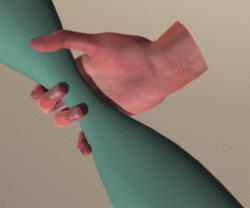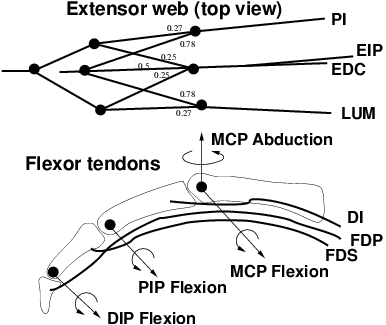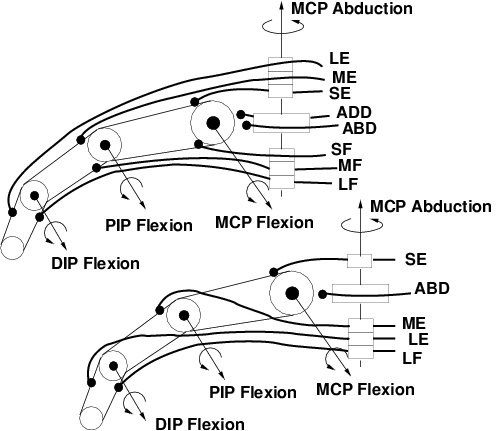


|



|
Use of the hand for grasping and manipulation requires a high level of dexterity, a high level of intelligence about the world. Examples of human grasps and manipulation tasks are a valuable resource for understanding dexterity and can serve as a rich starting point for creating dexterous manipulation capabilities in robots and graphical characters.
One challenge is to develop controllers that can be used to simulate humanlike grasps. We have explored development of an effective grasping controller from human demonstrations. Victor Zordan (Assistant Professor at UC Riverside) and I have proposed a simple model for a grasping controller and fit the parameters of that model using captured human motion data. We have found that this controller can produce good results over a range of object geometries (SCA 2005).
The choice of a grasp for any given object should reflect the requirements of the task to be performed. We must be able to move or manipulate the object, the grasp must be robust to external disturbances, and it must be designed so that appropriate forces can be applied to the object without excessive effort. We believe that understanding some of the factors driving human grasp choice can help us to create more natural looking grasps for human characters and design robot hands that are capable of grasping and manipulating objects in a humanlike manner. One goal of grasp choice for robotics is to choose contact points that guarantee properties such as force- or form-closure. Many efficient algorithms have been developed to address this problem, but most of these algorithms focus on grasps having a minimal number of contact points. Some of our recent work (IJRR 2004) has focused on algorithms that work well for large numbers of contacts.
Increasing the number of contacts can dramatically improve the quality and flexibility of grasps that are constructed. However, computation time becomes a problem, as grasp synthesis algorithms that can be generalized to an arbitrary number of contacts typically require time exponential in the number of contacts.
Our work shows that using examples of successful human grasps can make the problem of grasp selection tractable for grasps having relatively large numbers of contacts. The key idea is to geometrically construct families of grasps around a single example such that all grasps within a family meet user specified design goals. Our construction technique can be used to form force-closure grasps, partial force-closure grasps, and grasps above a quality threshold. The approach requires time polynomial in the number of contacts, making it feasible to handle grasps with relatively large numbers of contacts. We have used this approach to design grasps for a robot hand and quasistatic manipulation plans for a humanoid robot.
One of the most important considerations for tool use is often ability to apply appropriate forces to an object. Think of a hand planer, an electric drill, or a hammer. Our IJRR 2004 paper explores how grasp examples can be used to synthesize new, similar grasps with guarantees on force capabilities. One limitation of this work, however, is that it assumes that all contacts between the hand and object are equal. In particular, this work assumes that all contacts have identical force capabilities, a property that is not at all true of grasps formed with the human hand. To understand whether force capabilities of these human example grasps fit the task to be performed, we need to have a model of force production in the human hand.
Force production capabilities of the human hand can be computed if maximum muscle forces and tendon moment arms are known. Although the tendon structure of the hand is complex, as suggested in the figure below, estimates for the required information can be readily obtained from the biomechanics literature.

|
To date, we have constructed a model of force production in the human index finger and evaluated this model by comparing our estimates of maximum force production to those available in the literature. We are currently in the process of extending this model to the remainder of the hand so that grasps such as those shown at the top of this page can be evaluated by comparing force capabilities to task requirements.
One interesting thing we can do with this model is compare human finger capabilities to those of a common tendon driven robot finger design. In our ICRA 2002 paper, we performed this experiment and found that common N+1 and 2N tendon designs, like those used in the Stanford/JPL (Salisbury) hand and the Utah/MIT hand respectively can be tuned to achieve force capabilities very similar to those of the human hand. These two robot tendon designs are shown below. Details and results of this tuning process can be found in the paper.

|